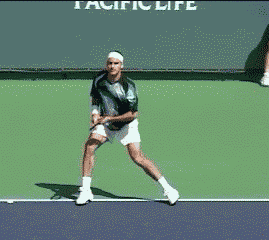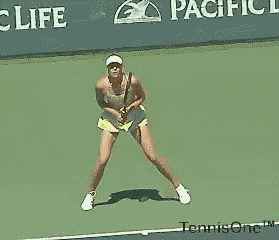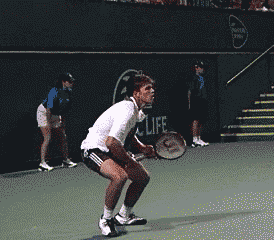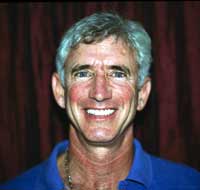|
TennisOne Lessons Play the 8 Way Federer Forehand by Jack Broudy I've spent a lifetime as a player, continuously attempting to mimic the strokes of the best in the game, from Sampras' serves and net game, to Agassi's groundies. What I have discovered in my quest is that the best players in the World exemplify eight basic principles and two essential keys in each and every stroke. Let's start with the forehand and you'll discover how the philosophy and principles are laced throughout the best forehands in the game.
The philosophy, which is wrapped up in the two keys is this: There is a small figure 8 motion generated in the hips that when performed properly creates a larger figure 8 in the arms. And all of this gyroscopic momentum is lined up with a 45º angle to the net, where power and control come together at what I feel is the ideal hitting point. It's these same two keys that enable a professional short-stop to catch and throw in the same motion, or Bruce Lee to land his patented three inch “death blow.” To emphasize this movement, we use the 8board, a product that not only replicates this move easier, it can help players groove their footwork and rotation.
Place the 8board at the service line, 45º to net. It is here where I believe lies the Ideal Hitting Point. Line up the 8board, and your body to the hit, by making sure you're facing the net post 45º to the net, directly in front of you. Facing the court at this 45º angle also gives you the optimal (“sharp-shooter's) view to the oncoming ball, as explored in “A View to a Feel.” Center your feet on each swivel of the 8board with your feet parallel, knees slightly bent. This posture, known to many as the “ready position,” encompasses the same component's that are used to create a “ balanced coil” which I believe is the basis for the forehand. Keeping your knees bent allows you to activate your hips, where the stroke is initiated. (Also of great benefit, the 8board swivels freest when the feet are centered on the discs.)
Face the Net to Begin Each Stroke. Although often you'll hear “wait with your racquet back,” it's apparent when watching the forehands of Agassi or Federer that they capture momentum in the backswing, with the hips pulling the arm slowly into a coil. The ball flight serves as a metronome for the player to develop rhythm. Generally the speed you go into the figure 8 hip rotation, is the speed you want to come out. Swivel your feet slowly and continuously. Here's where your developing the small figure 8 motion in your hips. Remember there is no starting or stopping in a figure 8 motion. It is a slow continuous movement. This is the precise motion that the “effortless” players like Federer and Rios have perfected. Eventually, you'll learn to relax and let your hips pull your feet and arms into play. (When you get accomplished at this you will feel your hips moving in both the horizontal, as well as the vertical planes.) Fly with both wings. Your two arms keep your body in balance at the 45º angle. The 45º angle is the mid-point of the stroke, and therefore becomes the balance point for the two arms. Think of a tight-rope walker who uses his two arms to stay in balance. The left arm ideally moves with the racquet head to the 45º and then it mirrors off of the 45º while the hitting arm continues into the backswing. To be precise, the left hand doesn't just “point” at the ball, the net, or the side fence, or for that matter it doesn't just touch the strings of the racquet. All of those tips have merit and players do them all, but they do not explain the real purpose of the left arm. The left hand and arm represent the left side of the body and is as important as the hitting (right) hand and arm when hitting a geometrically correct forehand, (or any stroke for that matter.) The left and right hand triangulate at the 45º angle, and from that point on, as the hips pull the right arm back, the left hand and arm “mirrors off” of the right arm with the center point being the 45º angle. Both arms stay coiled, meaning there is always a degree of roundness in each arm.
Both the left and right hand move, with the hips, until they face the 45º angle, where the hands come to a point. At this point in the geometrically correct forehand (of Federer) the hands break apart and mirror one another with the 45º plane as their center or balance point. Then as the right arm is “flung” out into the 45º contact point, the left arm continues to hold the balance on that same hitting point. Notice how the left hand of Federer stays connected to the 45º at the contact point, keeping his balance and focus right there. (At any point in the stroke the arms are balanced on the hitting point at the 45º.) The racquet moves in Figure 8, rising and falling with the rise and fall of the ball. As I've mentioned, the small figure 8 motion in the hips creates a larger figure 8 movement with the racquet at the periphery. The idea here is not to exaggerate or necessarily replicate an exact figure 8, but to move the racquet and body with the movement of the ball, and generally that is up over the net and down into the court. By replicating or mimicking the flight of the ball, you stay “connected” to it from the time it leaves your opponent's strings until it reaches yours. Your head remains still, while your eyes follow the ball from the other side of the court to your contact point. This principle is covered extensively in my recent article A View to A Feel. Lining your body up to the hit at the 45º angle, you peer out at the oncoming ball as if you were shooting a rifle or bow and arrow. Keeping your head relatively quiet enables you to watch the line of the ball (the ball's flight path rather than being obsessed with the ball itself. Not only does this give you a better view of the ball, but it allows your body to move below you without getting stuck somewhere in the stroke. Moving your head while you track the ball and swing makes about as much sense as watching your feet when you dance.
Start small at the 45º angle then extend out to the hit at the 45º. The figure 8 motion rippling throughout your body to your racquet head provides power and a degree of “whippiness.” The 45º angle is where you keep your body oriented throughout the stroke. It's the balance point, the mid-point of the stroke, and its how you “tame” the stroke. Many juniors today have the figure 8 looseness, but they lack consistency and control, because they don't have the 45º angle as their point of contact. Of course Roger Federer is our poster boy for the forehand because he gets (his arm and racquet) the furthest out on the “periphery.” His arm is almost fully extended! Roger gets his “effortless” power not only because his arm is extended, but he has an excellent connection from his hips to his hitting arm. That's one of the 8 reasons there's such a big difference between Roger's forehand and everyone else's. Most touring pros, have many of these principles mastered, but Federer has them all. Sharapova does orient her stroke to the 45º angle and her racquet edge does go out along that line to the hit, but she doesn't get full extension at the hit the way Roger does. It's because her hip-arm figure 8 connection is just OK and therefore she “muscles” the ball a bit.
You'll notice, if you watch carefully, that often when she contacts the ball both her hips and chest are facing the 45ºangle, and its her arm that does most of the work. Where Roger's arm is flung out into the hit (like a discus thrower), Maria “arms” the shot more, wasting energy. Taylor Dent, although bigger in size than Federer, does not have the bigger forehand, primarily because his body doesn't stay lined up to the hit. Therefore, he also does not get full extension or the same weight behind the hit. He's pulls both his hips and his chest (and left hand) out of line with the 45º angle and the hit. You can see he's actually facing the net with his entire body at contact. He doesn't get the leverage from his body because his arms out there all alone without the body to support it. Start to notice players more carefully and see whether or not you can pick up these 8 traits. You may need to see them in slow motion at first. Then try these 8 basic principles (check points) on your own forehand. The 8board can be an invaluable tool to make sure that as you perform the shot, you maintain “dynamic balance,” which means balance and symmetry while in motion. Your comments are welcome. Let us know what you think about Jack Broudy's article by emailing us here at TennisONE 8Board Tennis SystemIf any of my articles regarding the nonlinear game and the 8Board® Tennis System strike a chord in you, whereby you can see the wisdom and intelligence in the game, please join us at our Grail Tennis Winter Forum in Southern California, January 11th and January 18th.
Broudy began working and collaborating with Paul Mayberry 10 years ago. Together they developed the 8Board Body Motion Coordinating System of training that has allowed Broudy's students to play World-class tennis and become national tournament winners. Currently Broudy coaches nationally ranked juniors and touring pros at the Four Seasons Aviara Resort in Carlsbad, CA. The author of The Real Spin on Tennis, Broudy is also a contributing writer for Tennisone.com, a tennis player, surfer, and musician. He serves as president of Grail Sports, Inc. |




 Jack Broudy was born and raised in Stamford, Connecticut and although he was active in many other sports activities, decided at age 14 he would pursue tennis as a career. He played in National Junior tours, the NCAAs, won many titles as a kid and went on to play winning tennis though his college years both at the University of North Carolina at Chapel Hill and UC San Diego.
Jack Broudy was born and raised in Stamford, Connecticut and although he was active in many other sports activities, decided at age 14 he would pursue tennis as a career. He played in National Junior tours, the NCAAs, won many titles as a kid and went on to play winning tennis though his college years both at the University of North Carolina at Chapel Hill and UC San Diego.